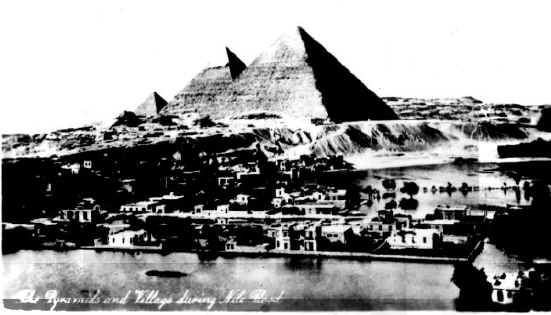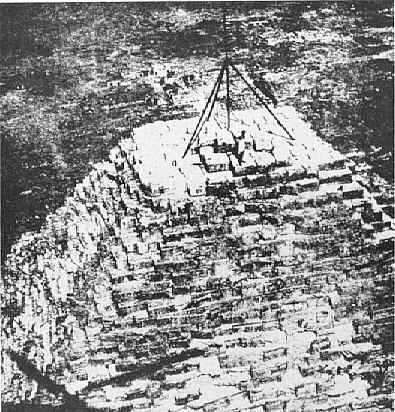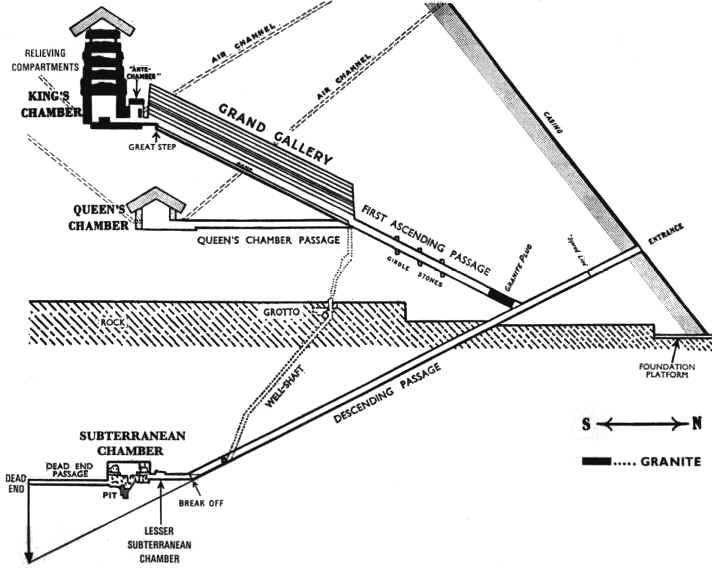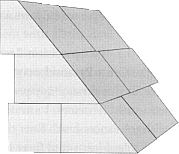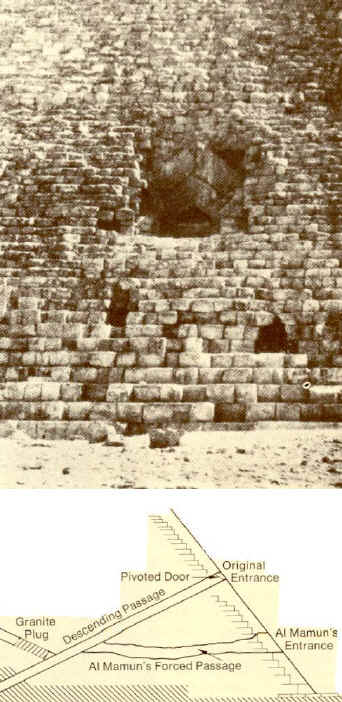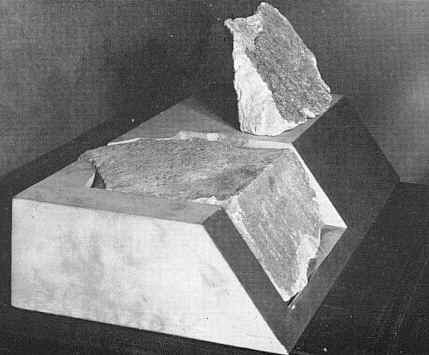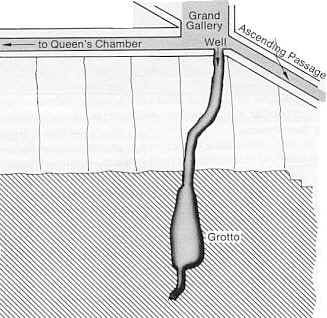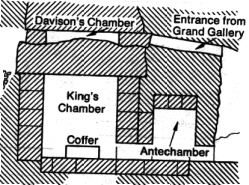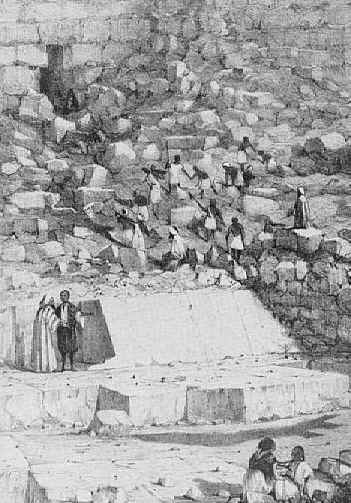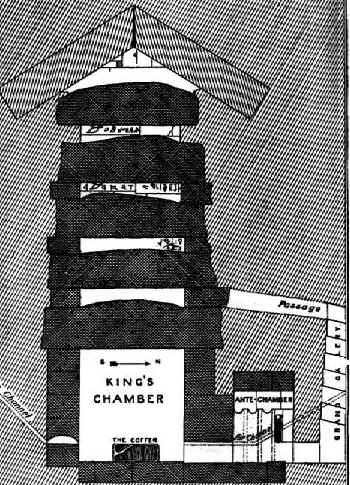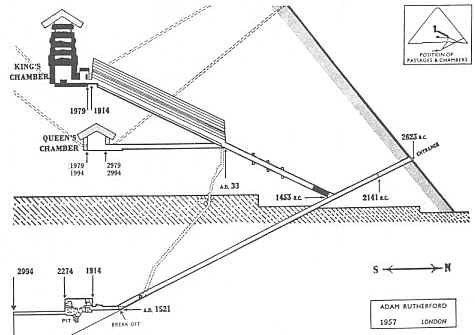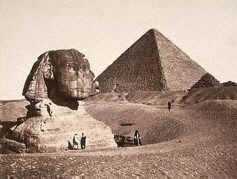 The Great Pyramid of Giza stands on the northern edge of the Giza Plateau, located about 10 miles west of Cairo. It is composed of over 2 ½ million blocks of limestone, which weigh from 2 to 70 tons each.
The Great Pyramid of Giza stands on the northern edge of the Giza Plateau, located about 10 miles west of Cairo. It is composed of over 2 ½ million blocks of limestone, which weigh from 2 to 70 tons each.
It's base covers over 13 acres and its volume is around 90,000,000 cubic feet. You could build 30 Empire State buildings with its masonry. It is 454 feet high which is equivalent to a modern 48-story building. There are currently 203 courses or steps to its summit. Each of the four triangular sides slope upward from the base at an angle of 51 degrees 51 minutes and each side has an area of 5 1/2 acres. The joints between adjacent blocks fit together with optical precision and less than a fiftieth of an inch separates the blocks. The cement that was used is extremely fine and strong and defies chemical analysis. Today, with all our modern science and engineering, we would not be able to build a Great Pyramid of Giza. The Great Pyramid is thought to have been erected around 2600 BC during the reign of Khufu (Cheops). Next to the Great Pyramid stands 2 additional large pyramids. The slightly smaller one is attributed to Cheop's son and successor , Kephren. The other, still smaller, is attributed to Kephren’s successor, the grandson of Cheops, Mykerionos. To the south-east of the Great Pyramid lies the Sphinx. The total number of identified pyramids in Egypt is about 80.
For more general information go to
The Great Pyramid of Giza is one of the seven wonders of the ancient world and the only one still remaining to this day. The other wonders are: The Colossus of Rhodes, The Statue of Zeus at Olympia, The Mausoleum at Halicarnassus, The Hanging Gardens of Babylon, The Temple of Artemis (Diana) at Ephesus, and The Lighthouse of Alexandria. The word pyramid is derived from the Greek words PYRAMIS and PYRAMIDOS. The meaning of the word Pryamis is obscure and may relate to the shape of a pyramid. The word Pyramidos has been translated as "Fire In The Middle" (From Stephen Mehler - The Land of Osiris Research Project) For more information go to THE ORIGIN OF THE WORD "PYRAMID"It appears that the Great Pyramid was never finished since the top is flat, and not pointed, as it should be. It has a truncated summit which is coarse and uneven and measures about 30 square feet. Most pyramids were crowned with a top-stone that completed their structure. This pyramid does not currently have one and it appears that it never did. One of the earliest references to the missing top-stone (or capstone) is from Diodorus Siculus (60 BC). He tells us that in his day, when the Pyramid stood with its casing stones intact, the structure was "complete and without the least decay, and yet it lacked its apex stone". Since the top-stone could not have been dismantled without first demolishing the smooth casing-stones, so that the core masonry formed steps of approach to it, this statement of Diodorus supports the theory that the top-stone had never been added to the structure. Also it appears that between the different courses of stones there is a thin cement which is absent on the upper surface of the highest course. Why the pyramid was never finished remains a mystery.
For more information about the Summit and missing capstone go to
It is safe to say that men have been seeking an answer to the riddle of the Great Pyramid for over 4000 years. Theories range from a tomb or monument for a Pharaoh, an astronomical observatory, a place for elaborate Egyptian rituals, a giant sundial, a grain storage structure, a prophetic monument, a water irrigation system, a repository for ancient knowledge, the Egyptian Book of the Dead immortalized in stone, a communication device to other worlds or realms, etc. The list goes on. Also the list of who build the Great Pyramid includes the Egyptians, Sethites, Atlantians, and aliens to name a few.
To take a tour of the Great Pyramid go to
Before the Great Pyramid came into existence its peculiar internal construction was unknown; after it no attempt was made to repeat it. It appears that the pyramids that came after it were a poor imitation and did not approach its magnificence. To quote Marsham Adams, the Oxford scholar "It is absolutely unique. No replica watches uk other building contains any structure bearing the least resemblance to the upper chambers.
Interior Features of the Great Pyramid
For a description of the Interior passages and chambers of the pyramid go to
Herodotus, the Greek historian of the fifth century BC, regarded as the father of history wrote the earliest description in existence of the pyramids. When Heroduotus visited the period in 440 B.C., it was as old to him and his period is to us. He wrote that each of the pyramids four faces were still covered with highly polished limestone (casing stone). Also the joints were so fine that they could hardly be seen.
Casing Stones of the Great Pyramid To manufacture just two blocks with a tolerance of .010 inch and place them together with a gap of no more than .020 inch is a remarkable feat. The Great Pyramid had at one time over 100,000 similar casing stones. Did the ancient Egyptians have replica breitling advanced technology? To read more about this go to THE GIZA POWER PLANT - The Mighty Crystal
Strabo, a geographer, visited the pyramids in 24 BC. He describes an entrance on the north face of the pyramid made of a hinged stone which could be raised but which was indistinguishable from the surrounding stone when closed. The location of this moveable door was lost during the 1st Century AD. Strabo also stated that this entrance led into a narrow and low passage, about 4 feet by 4 feet, which descended 374 feet into a damp, vermin-infested pit dug from the bedrock 150 feet below the base of the Pyramid. In 813 AD, an Arab, Abdullah Al Mamum came to the throne and was fascinated with the Great Pyramid. He searched for a secret entrance into the pyramid but could not find one. In 820, his workman tried to burrow straight into the solid rock of the pyramid in hope of running across a passage that led to the interior. They tunneled into the solid core of the pyramid for over 100 feet and were about to give up but they heard the sound of something falling to the east of the tunnel. They altered there tunneling to the direction of the sound and eventually broke into the descending passage. The workers stated that it was "exceeding dark, dreadful to look at, and difficult to pass. " The passage was 3 1/2 feet wide by 3 feet 11 inches high. It sloped down at an angle of 26 degrees. Struggling up the passage the Arabs discovered the original entrance about 90 feet to the north. It had been placed 49 feet above the base of the Pyramid, ten courses higher than Al Mamun had guessed, and 24 feet east of the main axis of the north face of the Pyramid. They found the entrance to the ascending passage but it was blocked by 3 large granite blocks. Unable to cut through these, they bore around the granite plugs through the softer cartier watch limestone blocks. Once clear of the plugs, they forced there way into the ascending passage. They went up the ascending passage and found themselves in the Grand Gallery, and from there explored the Queen's Chamber and the King's Chamber. The men searched everywhere for treasure but the only thing they found was a large lidless coffin of highly polished granite.
For more information about the coffin go to Original Entrance and below Al Mamun's forced Entrance
In the 14th century a series of earthquakes destroyed parts of northern Egypt. The Arabs decided to strip the pyramid of its casing stones to use in rebuilding bridges, mosques, palaces, etc. Eventually the pyramid was completely stripped of its beautiful casing stones and the core masonry was exposed to weathering. The core blocks proved to be of either pure limestone or nummulitic limestone containing large quantities of fossil shells resembling coins.
The earliest investigator to give any really scientific data of the Great Pyramid was the Oxford astronomer John Greaves. He visited Egypt in 1637 in order to explore thoroughly its pyramids, and in particular the Great Pyramid. He made a new discovery that others had missed. At the beginning of the Grand Gallery towards one side, a stone block had been removed and a passage appeared to have been dug straight down into the depths of the pyramid. He had discovered the entrance to the so called "Well Shaft". The opening was a little over 3 feet wide and notches were carved opposite one another on the sides of this shaft so someone could climb down with support. Greaves lowered himself down to about 60 feet, where he found that the shaft was enlarged into a small chamber or grotto. The shaft continued below him but it was so dark and the air was foul that he decided to climb back up. The purpose of this Well Shaft puzzled him.
He published his investigations under the title, Pyramidographia: A Description of the Pyramids in Egypt (1646). This was the first book ever published just on the Great Pyramid. His work gave a great stimulus to other investigators, and he was soon followed by English, French, German, Dutch, and Italian explorers.
For information about why Isaac Newton had an interest in the Pyramid go to
The next important contributor was Nathaniel Davison, British Consul at Algiers in 1763. He was the first to discover the lowest of the series of five spaces (called "Construction Chambers") over the King’s Chamber. The story is that at the top of the Grand Gallery, he noticed that his voice was echoed in a strange way and seemed to resonate from above him. Davison tied a candle at the end of two long canes, raised it up, and noticed at the top of the Grand Gallery a small rectangular hole about 2 feet wide. He put 7 ladders together to climb to the top. He found 16 inches of bat dung in this 2 foot hole that had accumulated throughout the centuries. Davison put a kerchief over his face and made his way into the hole. After crawling 25 feet, he reached a chamber about 3 feet high but as wide and as long as the Kings chamber beneath. He observed that the floor consisted of the tops of 9 rough hewn granite slabs each weighing up to 70 tons. The ceiling of the King's Chamber was formed by the under sides of these blocks. He also noticed the ceiling of this chamber was also constructed of a similar row of granite blocks. This is a far as he went. This chamber referred to as "Davison’s Chamber" was named after him. His measurements also confirmed the fact that the pyramid was constructed so that its sides faced the cardinal points of a compass.
Following Davison, there was the important survey of the Great Pyramid carried out by the French savants who accompanied Napoleon to Egypt in 1799. Napoleon came to conquer Egypt with a force of 35,000 soldiers in 328 sailing vessels. Besides his military, he brought a collection of 175 French civilians (known as savants) who had a knowledge of Egyptian antiquities. There job was to explore, measure, study, etc. the pyramids and monuments of ancient Egypt. They did not discover anything sensational in the pyramid because of the hindrance of bats. They did notice that if they shot their pistols at the top of the Grand Gallery, a repeated echo occurred that sounded like thunder moving away into the distance. They were the first to survey the site trigonometrically and to discover two of the corner sockets at the base. As far as we know, no other pyramid has corner sockets. They published their monumental work at the order of Napoleon. This work was completed and published over a 25 year period and consisted of 9 folio volumes of text and 12 folio volumes of plates. Actually the most important discovery the French made was the Rosetta stone uncovered in a branch of the Delta near Rosetta. This three foot diorite slab was engraved with hieroglyphics, demotic Egyptian, and Greek. The Rosetta stone enabled J.F. Champolion the means for deciphering ancient Egyptian hieroglyphics.
For a fascinating story of Napoleon's visit to the King's Chamber go to
An Italian named Captain Caviglia was sized by the mystery of the Great Pyramid and decided to give up the sea and explore the pyramid. Believe it or not, Caviglia cleaned out the bat dung from Davison's Chamber and turned it into an apartment in which he resided. Caviglia was able to clean out the debris in the Well Shaft where it connected with the descending passage. However, it was Colonel Howard Vyse who, in 1837, at the expense of a large fortune, and after seven months of work, with over a hundred assistants, brought the Great Pyramid within the sphere of modern scientific investigation. Colonel Vyse re-opened the forced entry made originally by Al Mamoun early in the ninth century AD. He also rediscovered the corner-sockets previously uncovered by the French in 1799. When Vyse decided to clear away some debris by the pyramid, he discovered two of the original polished limestone casing stones.
Vyse also discovered and opened up the air shafts to the King’s Chamber. He had discovered that these shafts extended over 200 feet to the outside of the pyramid. Once opened, an immediate rush of cool air entered the King's Chamber and maintained an even temperature of 68 degrees regardless of the weather outside.
For the story of the opening of the air shafts go to
Vyse also discovered four other chambers above Davison’s Chamber. It was while exploring these chambers that Colonel Vyse came across the cartouches of Khufu and his brother Khafra, as co-regent with him, in the form of mason’s marks, painted in red ochre – sometimes inverted- on the ceiling beams. Colonel Vyse also dug up the floor in the Queen's chamber but only found an old basket so they refilled the holes. The story about how Colonel Vyse discovered the other chambers above Davison's Chamber is very interesting. Vyse found a crack in the ceiling in Davison's chamber so he decided to run a reed through this crack. It went for about 3 feet before it stopped. Thus they suspected another chamber above Davison's. They tried to chisel through the granite overhead but it was too hard. Special quarrymen were brought in and they could not even break through the hard granite. Colonel Vyse found a man who was called Daued. He lived mainly on hashish and alcohol. Daued used gunpowder to blast his way into the upper chamber. This was very dangerous since the blasted granite flew like shrapnel. This was successful and Vyse had discovered another chamber above Davison's which he named Wellington's chamber. Three other chambers above these two were discovered making a total of 5 chambers above the King's Chamber. Vyse published his work in 1837 under the title "Operations Carried on at the Pyramid of Gizeh".
For more information about exploring above the King's chamber go to
The study of the Great Pyramid came to a new era with the work of Robert Menzies, of Scotland. He was the first to assert that the Great Pyramid was a treasury of Divinely given wisdom embodying chronological, meteorological, astronomical, mathematical, historical and Biblical truths. He also contended that this storehouse of wisdom remained sealed by Divine appointment, to be revealed to those now living; to whom these truths would bear witness, at a time when they would be most needed. John Taylor, a mathematician and amateur astronomer, began a study of the measurements of the Great Pyramid. He published his conclusions in 1859 in the book The Great Pyramid: Why was it built? He also believed that the Great Pyramid embodied certain scientific and biblical facts and he questioned whether or not the Egyptians built the Great Pyramid. He believed the builders of the Great Pyramid were divinely inspired. The pyramid contained prophetic time lines that gave important biblical and secular dates. This was the beginning of the field called "Pyramidology". The pyramid was sometimes referred to by the pyramidologists as the Bible in stone. Following Taylor, Piazzi Smith, astronomer royal for Scotland and a pyramidologist, made his survey of the Great Pyramid during the winter of 1864-65. He, like Taylor, believed that the Great Pyramid enshrined mathematical, astronomical, and geophysical facts and that it was build by divine guidance. It also contained a prophetic timeline that predicted the Exodus, crucifixion of Christ, the Second Coming of Christ, and the end of the world. His well known work Our Inheritance in the Great Pyramid is one of the most popular classic works on the great pyramid. In the United States, pyramidology was popularized by Joseph Seiss who wrote Miracle in Stone in 1878. This book was widely read and distributed. The next important contributor was a mechanical engineer, Sir William Flinders Petrie. With steel tapes and special chains 1200 inches long, Petrie measured the pyramid with a great accuracy. Petrie published his work in 1883 in a book entitled The Pyramids and Temples of Gizeh.
To read about the Edgar brothers exploration of the pyramid in 1909 go to
In 1924, a structural engineer from England, David Davidson published a monumental work on the Great Pyramid entitled The Great Pyramid: Its Divine Message. He also believed the Great Pyramid was of divine origin and contained mathematical relations in its architecture. He also included a comprehensive prophetic time line, which also predicted biblical and secular events. He concluded that the Great Pyramid was "an expression of the Truth in structural form and that it establishes the Bible as the inspired word of God. " In 1929, Basil Stewart published The Mystery of the Great Pyramid, which was one of the first publications examining the close connection existing between the Great Pyramid and the Egyptian Book of the Dead.
For an article about the Book of the Dead go to
One of the most famous Pyramidologists was Adam Rutherford whose 4-volume set of Pyramidology, published in the 1970’s is considered the textbook for pyramidologists. Rutherford, like previous pyramidologists, believed in the prophetic time line in the pyramid and he predicted the Second Coming of Christ and the end of the world from this timeline. Since the predicted dates for the Second Coming of Christ and the end of the world never materialized, many people lost interest in pyramidology. Pyramidologists continue to revise and update their timelines, predictions, and studies of the Great Pyramid and pyramidology is still pursued today with renewed interest. For an article on Pyramidology to go
Much of the research today on the Great Pyramid is carried out by archeologists, engineers, scientists, architects, mathematicians, and scholars from many disciplines.
To read some new and innovative theories about the Great Pyramid go to
It is one of the greatest mysteries of all time. Some of the more interesting research consists in searching for undiscovered chambers and passages using high tech equipment. What may be discovered is an exciting thought.
For articles on the search for hidden chambers go to
MAJOR REFERENCES FOR THIS ARTICLE Secrets of the Great Pyramid by Peter Tompkins The Giza Power Plant by Christopher Dunn Pyramidolgy by Adam Rutherford - 4 Volumes The Great Pyramid Decoded by E. Raymond Capt For additional references go to REFERENCES USED ON THIS WEB SITE |
Home
